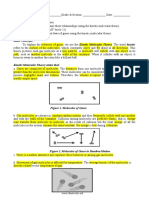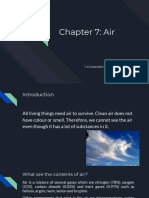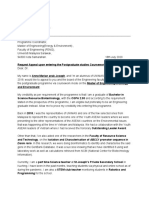0 ratings0% found this document useful (0 votes)
38 viewsGas Pressure
Gas Pressure
Uploaded by
Anne Marian Anak JOSEPHGas pressure is caused by the collisions of rapidly moving gas particles with each other and the walls of their container according to the kinetic theory of gases. Reducing the volume of a container increases the frequency of collisions, raising the pressure, while higher temperatures also increase pressure by accelerating the particles' movement. Common tools to measure gas pressure include the Bourdon gauge and manometer.
Copyright:
© All Rights Reserved
Available Formats
Download as PDF, TXT or read online from Scribd
Gas Pressure
Gas Pressure
Uploaded by
Anne Marian Anak JOSEPH0 ratings0% found this document useful (0 votes)
38 views2 pagesGas pressure is caused by the collisions of rapidly moving gas particles with each other and the walls of their container according to the kinetic theory of gases. Reducing the volume of a container increases the frequency of collisions, raising the pressure, while higher temperatures also increase pressure by accelerating the particles' movement. Common tools to measure gas pressure include the Bourdon gauge and manometer.
Original Title
Gas pressure
Copyright
© © All Rights Reserved
Available Formats
PDF, TXT or read online from Scribd
Share this document
Did you find this document useful?
Is this content inappropriate?
Gas pressure is caused by the collisions of rapidly moving gas particles with each other and the walls of their container according to the kinetic theory of gases. Reducing the volume of a container increases the frequency of collisions, raising the pressure, while higher temperatures also increase pressure by accelerating the particles' movement. Common tools to measure gas pressure include the Bourdon gauge and manometer.
Copyright:
© All Rights Reserved
Available Formats
Download as PDF, TXT or read online from Scribd
Download as pdf or txt
0 ratings0% found this document useful (0 votes)
38 views2 pagesGas Pressure
Gas Pressure
Uploaded by
Anne Marian Anak JOSEPHGas pressure is caused by the collisions of rapidly moving gas particles with each other and the walls of their container according to the kinetic theory of gases. Reducing the volume of a container increases the frequency of collisions, raising the pressure, while higher temperatures also increase pressure by accelerating the particles' movement. Common tools to measure gas pressure include the Bourdon gauge and manometer.
Copyright:
© All Rights Reserved
Available Formats
Download as PDF, TXT or read online from Scribd
Download as pdf or txt
You are on page 1of 2
Gas Pressure
1. Gas pressure can be explained by using the kinetic theory of gas
2. This theory states that gas consists of fine and discrete particles that always move
randomly in all directions.
3. In closed containers, the moving air particles will collide with each other and the walls
of the containers.
4. The collision between air particles and the walls of the containers produces air
pressure.
5. When the volume of the container is reduced, the air particles will collide more
frequently with each other and the wall of the container. Therefore, it will increase
the air pressure in the container.
Factor Effect on Gas Pressure
Volume The smaller the volume, the higher the gas
pressure
Temperature The higher the temperature, the higher the
gas pressure
Tools that can measure Gas pressure inside a closed container
BOURDON GAUGE
MANOMETER
You might also like
- Pressure (Part 2)Document2 pagesPressure (Part 2)Anne Marian Anak JOSEPHNo ratings yet
- Pressure__temperature_in_gasesDocument5 pagesPressure__temperature_in_gasesfiyojif743No ratings yet
- The Gas Laws: Porschia Marie D. Rosalem, LPTDocument48 pagesThe Gas Laws: Porschia Marie D. Rosalem, LPTGio Rico Naquila EscoñaNo ratings yet
- Fluid Mechanics Answer KeyDocument2 pagesFluid Mechanics Answer KeySeedy B Fofana100% (1)
- Ep103 Foundation in Chemistry Ii Laboratory Report: Experiment 1 Boyle'S LawDocument7 pagesEp103 Foundation in Chemistry Ii Laboratory Report: Experiment 1 Boyle'S LawKuneswaran RengasamyNo ratings yet
- 4.4 Gas Laws 2020 AnswersDocument15 pages4.4 Gas Laws 2020 AnswersFie MarzukhiNo ratings yet
- Fluids in Physics and PressureDocument3 pagesFluids in Physics and Pressurewendolyne.y.dejesusNo ratings yet
- S10MT Iva B 21 KINETIC MOLECULAR THEORY ABUEVADocument5 pagesS10MT Iva B 21 KINETIC MOLECULAR THEORY ABUEVALeil Riego0% (1)
- Properties of Gases: A Chem1 Supplement TextDocument29 pagesProperties of Gases: A Chem1 Supplement Textcandex10No ratings yet
- GasesDocument32 pagesGasesrichmondmamerga19No ratings yet
- BoyleDocument2 pagesBoylejamarlNo ratings yet
- Practice 1 Physical Behavior of Ideal GasesDocument8 pagesPractice 1 Physical Behavior of Ideal GasesScribdTranslationsNo ratings yet
- General Chemistry Prelims ReviewerDocument14 pagesGeneral Chemistry Prelims ReviewerSophia BrionesNo ratings yet
- UP2 - Ch2. The Kinetic Theory of GasesDocument42 pagesUP2 - Ch2. The Kinetic Theory of Gasesdarnit2703No ratings yet
- Reviewer - KMT Gas BehaviorDocument2 pagesReviewer - KMT Gas BehaviorMom GieNo ratings yet
- 0 07-Gases (v.0.1.070719)Document5 pages0 07-Gases (v.0.1.070719)rr orejudosNo ratings yet
- Properties of GasesDocument6 pagesProperties of GasesclairowrightsNo ratings yet
- DISCUSSION PVT ExperimentDocument3 pagesDISCUSSION PVT ExperimentNurul Shazwani AdzhariNo ratings yet
- Laporan Akhir - K-068-020-FD - Hernanda FebrianDocument18 pagesLaporan Akhir - K-068-020-FD - Hernanda FebrianDimas Bayu DarmawanNo ratings yet
- UntitledDocument1 pageUntitledjenz mantosNo ratings yet
- GASES SendingDocument2 pagesGASES Sendingyoow.youthNo ratings yet
- PVTfullDocument19 pagesPVTfullahmad pidotNo ratings yet
- 04 Gas LawsDocument12 pages04 Gas LawsmelissaNo ratings yet
- P V T P V T ConstantDocument7 pagesP V T P V T ConstantNoa BawieNo ratings yet
- SCIENCE 10 Q4 SLM4.kenitic MoleculartheoryDocument12 pagesSCIENCE 10 Q4 SLM4.kenitic Moleculartheorysharlenelawig5No ratings yet
- Gas LawsDocument80 pagesGas LawsChennille Ann Bleu GundayaoNo ratings yet
- Gas DiffusionDocument6 pagesGas DiffusionAnonymous bYHQo3gAn6No ratings yet
- Gases: Animation 3.1: Boyle's Law Source & Credit: WikipediaDocument55 pagesGases: Animation 3.1: Boyle's Law Source & Credit: WikipediaMian MuneebNo ratings yet
- Strand 2.2 - Energy (Yr 12 Phy)Document4 pagesStrand 2.2 - Energy (Yr 12 Phy)Sumeet KumarNo ratings yet
- Student Text 19Document25 pagesStudent Text 19astromaze10No ratings yet
- Science Q4 ReviewerDocument7 pagesScience Q4 ReviewerivzenieNo ratings yet
- 10.simple Kinetic Molecular Model of MatterDocument5 pages10.simple Kinetic Molecular Model of Matterbaokopo185No ratings yet
- Kinetic Theory of MatterDocument6 pagesKinetic Theory of Matteranwar9602020No ratings yet
- Fluidi MaturskiDocument25 pagesFluidi MaturskiFarisNo ratings yet
- Properties Measurement PVT Lab Report UitmDocument35 pagesProperties Measurement PVT Lab Report UitmAmrun Rusrl100% (1)
- General Chemistry 1 Mrs. Lesette O. Marquez: SentencesDocument2 pagesGeneral Chemistry 1 Mrs. Lesette O. Marquez: Sentencessheryn valdejuezaNo ratings yet
- Ch5 ChemDocument21 pagesCh5 ChemNishwa NiaziNo ratings yet
- ConChem Guide 4t QuarterDocument19 pagesConChem Guide 4t QuarterKiller KnightNo ratings yet
- Final SciDocument6 pagesFinal SciDANAO, Izek Hyden P.No ratings yet
- Q4 Week 1Document10 pagesQ4 Week 1Claudie MabiniNo ratings yet
- KMT-Boyle's LawDocument38 pagesKMT-Boyle's LawAngelyn AbuevaNo ratings yet
- Gas Expansion Lab Experiment 2 EH243 3C Group 3Document24 pagesGas Expansion Lab Experiment 2 EH243 3C Group 3Madihi NorhadiNo ratings yet
- 4.state of Matter - Gases and Liquids - 72-95Document19 pages4.state of Matter - Gases and Liquids - 72-95eamcetmaterials100% (4)
- The Kinetic-Molecular Theory Explains The Behavior of Gases, Part IDocument6 pagesThe Kinetic-Molecular Theory Explains The Behavior of Gases, Part I민머오No ratings yet
- 3757-Article Text-9633-1-10-20230209Document6 pages3757-Article Text-9633-1-10-20230209Shita RahimNo ratings yet
- ConclusionDocument25 pagesConclusionAbdur RashidNo ratings yet
- Chemistry & PhysicsDocument200 pagesChemistry & Physicsmoseszgambo59No ratings yet
- IB Lab 4. Molecular Mass of A Volatile LiquidDocument12 pagesIB Lab 4. Molecular Mass of A Volatile LiquidAnonymous orNHXM0f0100% (1)
- C9 Kinetic Model of MatterDocument6 pagesC9 Kinetic Model of Matterdepressed fishNo ratings yet
- 8 Science Fluids Lesson 19Document5 pages8 Science Fluids Lesson 19Trần Hà MyNo ratings yet
- Activity # 8 Gas LawDocument3 pagesActivity # 8 Gas LaweeeearllNo ratings yet
- Table 1. Properties of Gases. More Units Aside From The Given Examples)Document3 pagesTable 1. Properties of Gases. More Units Aside From The Given Examples)June Kathleen MandayoNo ratings yet
- Science 4THDocument4 pagesScience 4THErich STAR LYRICSNo ratings yet
- Behavior of GasesDocument27 pagesBehavior of GasesIvan BobeNo ratings yet
- Sekolah Tun Fatimah Johor Bahru Science Module Form TwoDocument7 pagesSekolah Tun Fatimah Johor Bahru Science Module Form TwointanNo ratings yet
- Avogadros EllaDocument5 pagesAvogadros EllaKayezelle BalaanNo ratings yet
- Phychem Expt #2Document7 pagesPhychem Expt #2Candace AguilarNo ratings yet
- Melting Point: Experiment 1Document5 pagesMelting Point: Experiment 1abasoudaNo ratings yet
- Hydrostatic PressureDocument11 pagesHydrostatic PressureTRPCL 3SNo ratings yet
- Pressure, Heat and Temperature - Physics for Kids - 5th Grade | Children's Physics BooksFrom EverandPressure, Heat and Temperature - Physics for Kids - 5th Grade | Children's Physics BooksNo ratings yet
- DSKP Syllabus Learning Area and ObjectivesDocument6 pagesDSKP Syllabus Learning Area and ObjectivesAnne Marian Anak JOSEPHNo ratings yet
- Wastewater Characterisation Study For Halal Abattoir Wastewater Treatment Plant in Siburan SarawakDocument35 pagesWastewater Characterisation Study For Halal Abattoir Wastewater Treatment Plant in Siburan SarawakAnne Marian Anak JOSEPHNo ratings yet
- F1 Chapter 3 TestDocument5 pagesF1 Chapter 3 TestAnne Marian Anak JOSEPHNo ratings yet
- Summative PracticeDocument4 pagesSummative PracticeAnne Marian Anak JOSEPHNo ratings yet
- Science Chapter 6 Periodic TableDocument27 pagesScience Chapter 6 Periodic TableAnne Marian Anak JOSEPHNo ratings yet
- F3 Compulsory ExperimentsDocument4 pagesF3 Compulsory ExperimentsAnne Marian Anak JOSEPHNo ratings yet
- Human Digestive SystemDocument4 pagesHuman Digestive SystemAnne Marian Anak JOSEPHNo ratings yet
- 3.1 Classes of FoodDocument8 pages3.1 Classes of FoodAnne Marian Anak JOSEPHNo ratings yet
- 1.1 Science Is Part of Daily LifeDocument1 page1.1 Science Is Part of Daily LifeAnne Marian Anak JOSEPHNo ratings yet
- Chapter 7 AirDocument31 pagesChapter 7 AirAnne Marian Anak JOSEPHNo ratings yet
- HypermetropiaDocument5 pagesHypermetropiaAnne Marian Anak JOSEPHNo ratings yet
- F2 Mid-Year Exam Section BDocument3 pagesF2 Mid-Year Exam Section BAnne Marian Anak JOSEPHNo ratings yet
- F2 Chapter 9 - HeatDocument6 pagesF2 Chapter 9 - HeatAnne Marian Anak JOSEPHNo ratings yet
- CombinepdfDocument50 pagesCombinepdfAnne Marian Anak JOSEPHNo ratings yet
- F1 Quiz Chapter 1Document3 pagesF1 Quiz Chapter 1Anne Marian Anak JOSEPHNo ratings yet
- Periodic Table Study Guide KeyDocument4 pagesPeriodic Table Study Guide KeyAnne Marian Anak JOSEPHNo ratings yet











































































